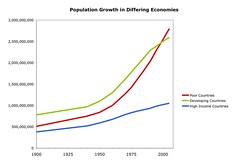These are the vocabulary words from Rubenstein's AP Human Geography textbook.
Chapter-1: Thinking Geographically
Chapter-2: Population
Chapter-3: Migration
Chapter-4: Folk and popular culture
Chapter-5: Language
Chapter-6: Religion
Chapter-7: Ethnicity
Chapter-8: Political Geography
Chapter-9: Development
Chapter-10: Agriculture
Chapter-11: Industry
Chapter-12: Services
Chapter-13: Urban Patterns
Chapter-14: Resource Issues
| 7770044171 | arithmetic density | The total number of people divided by the total land area |  | 0 |
| 7770044172 | Census | A complete enumeration of a population |  | 1 |
| 7770044173 | Crude Birth Rate (CBR) | The number of live births in a year for every 1,000 people alive in a society |  | 2 |
| 7770044174 | Crude Death Rate (CDR) | The number of deaths in a year per 1,000 people alive in a society |  | 3 |
| 7770044175 | Demographic Transition | the process of change in a society's population as a combination of medical advances and economic development, affecting a population's desire and ability to control its own birth and death rates |  | 4 |
| 7770044176 | 5 stages of Demographic Transition | 1. Total population is low but it is balanced due to high birth rates and high death rates. 2. Total population rises as death rates fall due to improvements in health care and sanitation. Birth rates remain high. 3. Total population is still rising rapidly. The gap between birth and death rates narrows due to the availability of contraception and fewer children being needed to work - due to the mechanisation of farming. The natural increase is high. 4. Total population is high, but it is balanced by a low birth rate and a low death rate. Birth control is widely available and there is a desire for smaller families. 5. Total population is high but going into decline due to an ageing population. There is a continued desire for smaller families, with people opting to have children later in life. | 5 | |
| 7770044177 | Demography | the scientific study of population characteristics |  | 6 |
| 7770044178 | Infant Mortality Rate | The total number of deaths in a year among infants under one year old per 1000 live births in a society |  | 7 |
| 7770044179 | Natural Increase Rate (NIR) | The percentage growth of a population in a year, computed as the crude birth rate minus the crude death rate (NIR=CBR-CDR) |  | 8 |
| 7770044180 | Physiological Population Density | The number of people per unit of area of arable land, which is land suitable for agriculture |  | 9 |
| 7770044181 | Population Composition | Structure of population in terms of age, sex and other properties such as marital status and education |  | 10 |
| 7770044182 | Population Density | A measurement of the number of people per given unit of land |  | 11 |
| 7770044183 | Population Distribution | Description of locations on Earth's surface where populations live |  | 12 |
| 7770044184 | Population Pyramid | A bar graph that represents the distribution of population by age and sex |  | 13 |
| 7770044185 | Total Fertility Rate (TFR) | The average number of children a woman will have during her childbearing years. |  | 14 |
| 7770044186 | Zero population growth (ZPG) | A decline of the total fertility rate to the point where the natural increase rate equals zero. |  | 15 |
| 7770044187 | Industrial Revolution | a series of improvements in industrial technology that transformed the process of manufacturing goods and drastically altered society |  | 16 |
| 7770044188 | Thomas Malthus | (1766-1834) An English economist who argued that increases in population would outgrow increases in food production, which would lead to widespread famine and disease. |  | 17 |
| 7770044189 | Dr. John Snow | (1813-1858) English physician who used hand-drawn data layering on maps of London to identify and treat a cholera epidemic |  | 18 |
| 7770044190 | Sustainability | the level of development that can be maintained without depleting resources |  | 19 |
| 7770044191 | Cartography | The science or practice of drawing maps. | 20 | |
| 7770044192 | Hearth | The area where an idea or cultural trait originates | 21 | |
| 7770044193 | Spatial Distribution | The physical location of geographic phenomena across space | 22 | |
| 7770044194 | Fieldwork | The study of phenomena by visiting places and observing how people interact with and thereby change those places | 23 | |
| 7770044195 | Sequent Occupation | The idea that successive societies leave their cultural imprint on a place and each contributing to the cummulative cultural landscape | 24 | |
| 7770044196 | Scale | A representation of a real-world phenomenon at a certail level of reduction or generalization. i.e on maps the ratio of ground distance to map distance | 25 | |
| 7770044197 | Political Map | focuses solely on the state and national boundaries of a place. They also include the locations of cities - both large and small, depending on the detail of the map. | 26 | |
| 7770044198 | Physical Map | shows the physical landscape features of a place. They generally show things like mountains, rivers and lakes and water is always shown with blue. Usually shown with different colors and shades to show topography. | 27 | |
| 7770044199 | Topographic Map | Shows different physical landscape features. They use contour lines instead of colors to show changes in the landscape | 28 | |
| 7770044200 | Climate Map | Shows information about the climate of an area; like the specific climatic zones based on the temperature, the amount of snow an area receives or average number of cloudy days. These maps normally use colors to show different climatic areas. | 29 | |
| 7770044201 | Economic or Resource Map | shows the specific type of economic activity or natural resources present in an area through the use of different symbols or colors | 30 | |
| 7770044202 | Road Map | A map that depicts roads, routes, highways, major and minor cities, as well as airports and points of interest | 31 | |
| 7770044203 | Thematic Map | focuses on a particular theme or special topic and they are different from the six aforementioned general reference maps because they do not just show natural features like rivers, cities, political subdivisions, elevation and highways. If these items are on a thematic map, they are background information and are used as reference points to enhance the map's theme. i.e. WWII Maps, a Map of the Industrial Revolution, etc | 32 | |
| 7770044204 | Stable Population Level | a population which has constant mortality and fertility rates, and no migration, therefore a fixed age distribution and constant growth rate. | 33 | |
| 7770044205 | Carrying Capacity | The number of living beings (people) that a specific area can support. i.e. SDS can only hold/accomodate so many people, it has a carrying capacity. Once reached changes must be made to space, resources, and accessibility | 34 | |
| 7770044206 | MDC | More Developed Countries. Average 10 years of schooling; a 98% Literacy Rate; sicker populations; and a Life Expectancy in the 70s. Regions: • North-America • Western Europe • Eastern Europe • Japan • South Pacific | 35 | |
| 7770044207 | LDC | Less Developed Countries. Average a couple years of schooling; a 60% Literacy Rate; healthier populations; and a Life Expectancy in the 60s Regions: • Latin America • East Asia • Middle East • Southeast Asia • South Asia • Sub-Saharan Africa | 36 | |
| 7770044208 | Hierarchical diffusion | Occurs when the diffusion innovation or concept spreads from a place or person of power or high susceptibility to another in a leveled pattern. Fashion, fads, trends, etc. Many people cutting their hair the way Taylor Swift did. | 37 | |
| 7770044209 | Stimulus Diffusion | Occurs when the innovative idea diffuses from its hearth outward, but the original idea is changed by the new adopters. Christianity and its many sects (Protestant, Baptist, Catholic etc) Different Menu items from McDonalds around the world. | 38 | |
| 7770044210 | Contagious Diffusion | Occurs when numerous places or people near the point of origin become adopters (or infected, in the case of a disease) Hinduism spreading throughout the Indian subcontinent | 39 | |
| 7770044211 | Relocation Diffusion | Involves the actual movement of the original adopters from their point of origin, or hearth, to a new place i.e. Spread of Christianity, when people moved and brought it with them | 40 | |
| 7770044212 | Formal Regions | Have one or more common characteristics that distinguish them from the surrounding area. i.e. states, countries, cities, areas of specific towns/cities/countries (wealthy vs. poor, industrial vs. residential) MEASURABLE DATA | 41 | |
| 7770044213 | Perceptual Regions | Defined by how the areas are perceived. Reflect people's feelings and emotions towards an area | 42 | |
| 7770044214 | Functional Regions | Defined by a system of interactions. Organized around a specific function (transportation, import/export) | 43 |

